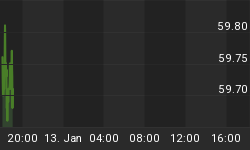Although last week was quiet on the data front, 10 year Treasury yields managed to temporarily crack the 4% barrier, trading down to 3.98%. As long as the US bond market sentiment gauges that I watch continue to be overwhelmingly bearish, the down-trades in bonds will be limited and should be viewed as buying opportunities in my opinion. In the meantime the US bond market seems to have contracted the Canadian disease of running the bond market up into supply and selling it off once the auctions are out of the way. Well done, fellas!
NOTEWORTHY: It was quiet on the economic data front last week. The one data point that continues to baffle was Jobless Claims on Thursday. They were reported at a stronger than expected 303k, the lowest reading in 4 years. While most indicators point to mediocre employment growth going forward, this indicator has been arguing for solid employment gains. I suppose we should wait for the next payroll number to see if the disconnect between Payrolls and Weekly Claims continues. One tidbit to point out would be that according to the latest Employment Report most of the 515k that left the workforce in January belonged to the 16-24 age-group to go back to school. These people are not submitting Jobless Claims. In the meantime layoff announcements continue at a strong pace. One fall-out from the increased M&A activity is an ongoing stream of job cuts. One other observation worthy of note is the fact that M3 is up over 100b over the past month or so. Not sure what is behind this substantial move but it could provide some additional fuel for financial markets across the board to rally. This week we have a pile of economic data to look forward to amidst a slowdown of earnings reports. Keep an eye on the sentiment numbers for clues on the economy. The bond market should also be influenced by Master Al's testimony in front of the Senate and Congress on Wednesday and Thursday. Although it is difficult to forecast what spin the talking heads will put on his commentary, I would be quite surprised to see/hear an overly hawkish testimony based on recent data.
INFLUENCES: Fixed income portfolio managers just don't want to let go of their bearish bias. (RT survey was down 2 points to 40% bullish. I need to see this number closer to 50% to turn negative on bonds.) The latest JPM portfolio manager survey shows a suffocating 3% bulls. Specs are short 6k T-note contracts (versus a short position of 55k last week), which is neutral sentiment. The 'smart money' commercials are still long a bullish 220k contracts (a decrease of 72k from last week's whopper of 292k). In addition to this, the public is way short the bond market as measured by the short interest on TLT (which is the ETF for the Lehman Long Treasury Index). Bonds are trading with an excellent tone. Market seasonals are negative going forward, but in my opinion the impact from this metric should be negligible at this juncture.
RATES: US Long Bond futures closed at 115-26, down 3 ticks on the week, while the yield on the US 10 year bond was up 1 bp to 4.08%. My bias remains positive. Long bond futures broke out of their trading range 2 weeks ago and followed through on their break-out. As mentioned above, we traded through our 4% target on 10 year Treasuries Wednesday last week. The pain trade is still up for prices (down for yields). Until positions and sentiment become less bearish, the dips will be shallow and the market will continue to power to lower yields. The Canada - US 10 year spread moved in 2 to 8 basis points. We are officially neutral on this spread at this point. Dec05 BA futures closed the week 61 basis points through Dec05 EuroDollar futures, which was in 4 basis points from last week's close. At 62 it was an official trade recommendation to buy EDZ5 to sell BAZ5. A weakening Canadian dollar should provide support for this spread to narrow. The belly of the Canadian curve was unchanged to the wings last week, but the belly is still cheap. Selling Canada 3.25% 12/2006 and Canada 5.75% 6/2033 to buy Canada 5.25% 6/2012 was at a pick-up of 51 basis points. A stable level on this trade implies a win for the belly. As the curve continues to flatten, the belly should continue to outperform. Assuming an unchanged curve, considering a 3-month time horizon, the total return (including roll-down) for the Canada bond maturing in 2012 is the best value on the curve. In the long end, the Canada 8% bonds maturing on June 1, 2023 continue to look like very good value.
CORPORATES: Corporate bond spreads were tighter last week. The buy side is way long this sector. Long TransCanada Pipeline bonds were in 2 basis points to 110, while long Ontario bonds were unchanged at 47.0. A starter short in TRAPs was recommended at 102 back in February 2004. Credit spreads are still excessively tight; there is loads of room to the wider side. Quality corporates should be favoured over lower rated issues. One of these days stock market volatility will break out of its coma and corporate bonds will bear the brunt of it.
BOTTOM LINE: I remain positive on bonds. The US front end is stuck in the mud, but it is still cheap. An overweight position in the belly of the curve is still recommended. Short exposure for the corporate sector was advised since February 2004. Sell BAZ5 to buy EDZ5 at a pick-up of 62 bps or better was recommended a few weeks back.
GENERAL COMMENTS: Not only are we heading into a negative seasonal on bonds, but seasonals are also becoming unfriendly on stocks as well.
















